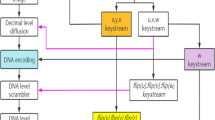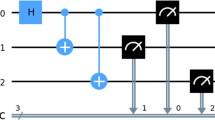Abstract
The need for information compression has become critical , particularly in quantum secure communication. It is presented a quantum secure primary communication with information compression. Quantum information can be divided into effective information and channel detection information improve transmission efficiency. The sending node will transmit effective information compressed in advance and channel detection information which are preprocessing by single photon to the receiving node. Meanwhile, the sending node will disclose the relevant content of channel detection information and check the security of quantum channel. If the channel is safe, the sending node will transmit the effective information decoding content to the receiving node. In process, the initial length of quantum information and the corresponding complexity of information as criteria of transmission efficiency, calculate and select the requirement compressed information to improve the transmission efficiency as far as possible. Then, it developed the simulated with MATLAB to calculate the relationship between transmission speed and compression length. In addition, it analyzes the security of communication protocol. The protocol has practical significance in improving the transmission speed from two aspects which are improving the transmission efficiency of quantum information and completing the whole communication process in one step.



Similar content being viewed by others
References
Teng, J. K., & Ma, H. Y. (2020). Dynamic asymmetric group key agreement protocol with traitor traceability. IET Information Security, 13(6), 703–710.
Ma, H. Y., Xu, P. A., Shao, C. H., et al. (2019). Quantum private query based on stable error correcting code in the case of noise. International Journal of Theoretical Physics, 58(12), 4241–4248.
Huang, B. H., Chen, Y. H., Wu, Q. C., et al. (2016). Fast generating Greenberger—Horne–Zeilinger state via iterative interaction pictures. Laser Physics Letters, 13(10), 105202.
Peng, Y., Shao, P. N., Li, X., Bai, J. F., & Meng, K. J. (2020). Lattice based verifiable secret sharing scheme. Computer System Application, 29(01), 225–230.
Bose, S. (2003). Quantum communication through an unmodulated spin chain. Physical Review Letters, 91(20), 207901.
Wang, Y., & Su, Q. (2020). Continuous variable measurement equipment independent cluster state quantum communication based on coherent state light field. Acta Electronica Sinica, 42(2), 307–314.
Yi, X. X., Jin, G. R., & Zhou, D. L. (2001). Creating Bell states and decoherence effects in a quantum-dot system. Physical Review A, 63(6), 151–159.
Liang, Y., Su, S. L., Wu, Q. C., et al. (2015). Adiabatic passage for three-dimensional entanglement generation through quantum Zeno dynamics. Optics Express, 23(4), 5064–5077.
Steinlechner, F., Ecker, S., Fink, M., et al. (2017). Distribution of high-dimensional entanglement via an intra-city free-space link. Nature Communication, 8, 15971.
Ma, H. Y., Teng, J. K., Hu, T., et al. (2020). Co-communication protocol of underwater sensor networks with quantum and acoustic communication capabilities. Wireless Personal Communications,. https://doi.org/10.1007/s11277-020-07192-7.
Shi, P., Li, N. C., Wang, S. M., Liu, Z., Ren, M. R., & MaMa, H. Y. (2019). Quantum Multi-User Broadcast Protocol for the “Platform as a Service” Model[J]. Sensors, 19(23), 5257.
Wei, C. Y., Cai, X. Q., Wang, T. Y., et al. (2020). Quantum anonymous authentication key exchange protocol based on quantum casual key transmission. Acta Electronica Sinica, 42(2), 341–347.
Zheng, S. B. (2009). Virtual-photon-induced quantum phase gates for two distant atoms trapped in separate cavities. Applied Physics Letters, 94(15), 116.
Chen, Y. H., Xia, Y., Chen, Q. Q., et al. (2015). Fast and noise-resistant implementation of quantum phase gates and creation of quantum entangled states. Physical Review A, 91(1), 012325.
Long, G. L., & Liu, X. S. (2002). Theoretically efficient high-capacity quantum-key-distribution scheme. Physical Review A, 65, 032302.
Gertner, Y., Ishai, Y., Kushilevitz, E., et al. (2000). Protecting data privacy in private information retrieval schemes. Journal of Computer System Sciences, 60(3), 592–629.
Deng, F. G., & Long, G. L. (2004). Secure direct communication with a quantum one-time pad. Physics, 69(5), 521–524.
Wang, C., Deng, F. G., Li, Y. S., et al. (2005). Quantum secure direct communication with high-dimension quantum superdense coding. Physical Review A, 71(4), 044305.
Lucamarini, M., & Mancini, S. (2005). Secure deterministic communication without entanglement. Physical Review Letters, 94(14), 140501.
Lee, H., Lim, J., & Yang, H. J. (2006). Quantum direct communication with authentication. Physical Review A, 73(4), 042305.
Lucamarini, M., Ceré, A., Giuseppe, G. D., et al. (2007). Two-way protocol with imperfect devices. Open Systems Information Dynamics, 14(02), 169–178.
Hu, J. Y., Yu, B., Jing, M. Y., et al. (2006). Experimental quantum secure direct communication with single photons. Light Science Applications, 5(9), e16144.
Ma, H. Y., Qin, G. Q., Fan, X. K., et al. (2015). Quantum network direct communication protocol over noisy channel. Acta Physica Sinica, 64(16), 36–42.
Zhou, L., Sheng, Y. B., & Long, G. L. (2020). Device-independent quantum secure direct communication against collective attacks. Science Bulletin, 65(01), 12–20.
Zhou, N. R., Zhu, K. N., & Zou, X. F. (2019). Multi-party semi-quantum key distribution protocol with four-particle cluster states. Annalen der Physik, 531(8), 1800520.
Yan, X. Y., Zhou, N. R., Gong, L. H., Wang, Y. Q., & Wen, X. J. (2019). High-dimensional quantum key distribution based on qudits transmission with quantum Fourier transform. Quantum Information Processing, 18(9), 271.
Mao, C. C., Zhang, C. H., Zhang, C. M., & Wang, Q. (2019). Improving the performance of four-intensity decoy-state measurement-device-independent quantum key distribution via heralded pair-coherent sources. Quantum Information Processing, 18(9), 290.
Liu, T., Zhu, C., Sun, C. Y., Fang, X. X., & Wang, P. P. (2019). Performance analysis of free space quantum key distribution with different wavelengths. Proc. SPIE 11339, AOPC 2019: Quantum Information Technology, 1133909.
Huang, B., Liu, L. H., Wang, Y., Huang, Y. M., & Peng, Z. M. (2019). Phase attack on reference pulses of continuous-variable quantum key distribution with real local oscillators. Proc. SPIE 11339, AOPC 2019: Quantum Information Technology, 1133903.
Liang, Y. X., & Liu, X. A. (2013). Method of generating unitary transformation for quantum data compression. Acta Physica Sinica, 62(20), 1–5.
Liu, X., Liang, Y. X., Nie, M., & Wei, Y. Y. (2017). Low complexity quantum compression algorithm for dimension reduction. Photoelectron Laser, 28(11), 1205–1211.
Acknowledgements
The work is supported by was supported by the Shandong Province Higher Educational Science and Technology Program (No. J18KZ012), and the National Natural Science Foundation of China (Nos. 11975132, 61772295),and the Shandong Provincial Natural Science Foundation, China (No. ZR2019YQ01).
Author information
Authors and Affiliations
Corresponding author
Additional information
Publisher's Note
Springer Nature remains neutral with regard to jurisdictional claims in published maps and institutional affiliations.
Rights and permissions
About this article
Cite this article
Ma, H., Zhang, X., Xu, P. et al. Quantum Secure Primary Communication Based on Quantum Information Compression. Wireless Pers Commun 113, 2203–2214 (2020). https://doi.org/10.1007/s11277-020-07319-w
Published:
Issue Date:
DOI: https://doi.org/10.1007/s11277-020-07319-w




